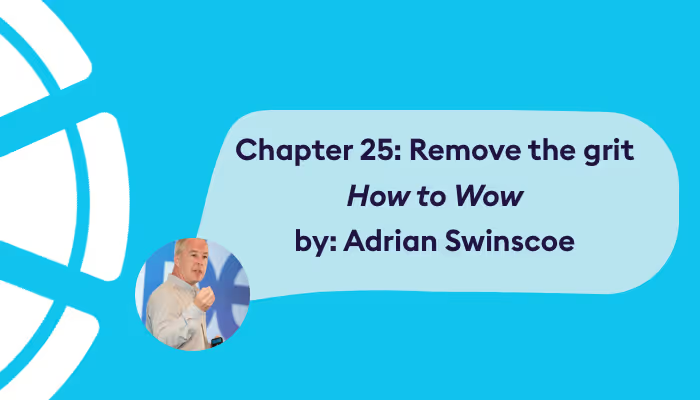We recently approached some of the best customer experience practitioners to get you the latest and most actionable CX content out there.
One of these is Adrian Swinscoe, who has kindly shared with us a free chapter from his indispensable book, How to Wow: 68 Effortless Ways to Make Every Customer Experience Amazing.
We hope you enjoy it as much as we did!
Happy reading :)

25.Remove the grit
Use this to help you identify and remove the small annoyances in your customer experience that distort the picture and always get remembered.
Often, in a bid to improve their customer service or experience, companies and brands find themselves focusing just on how they can add a delight or wow factor to their customer service or experience. In doing so, they tend to overlook the minor glitches or frustrations customers might have when they do business with them.
However, in doing so they risk ignoring the very things that customers tend to remember.
It’s a bit like walking to your next meeting or appointment and noticing that you have a piece of grit (small stone) in your shoe. Now, you may be a bit pressed for time and the grit doesn’t hurt so much that you have to stop to remove it. However, it’s always there and once you arrive at your destination, what do you remember about your journey? The grit in your shoe, right?
That’s all to do with how the memory works and the fact that we, generally, remember feelings, particularly annoyances and disappointments, better than anything else.
The great American poet and author, Maya Angelou, sums this idea very well when she said :
“People will forget what you said. People will forget what you did. But, people will never forget how you made them feel.”
Insight in action
Ruter, the public transport body of Oslo, uses this principle in improving it’s customer experience and is continually investigating the things that annoy or irritate their customers. In fact, on realising the power of this insight, Ruter’s CEO made a public announcement saying that Ruter’s strategy from now on was to ‘stop irritating you’.
Doing so has earned him and Ruter a large amount of respect and credibility in Norway.
In practice, Ruter has made a series of small changes to how it operates its business including changes like, whilst buses are waiting for the right time to depart, they now let their customers wait inside the bus rather than outside in the bus shelter in the cold.
How to use it
From time to time there will be little things in our customer experience that annoy or irritate our customers. These are often overlooked but shouldn’t be as they tend to be the things that customers remember.
If firms want to go about locating and removing the ‘grit’ in their customer experience these questions will help:
- Ask your customers a question like this: “Is there anything that we do, however slight, that annoys you or has annoyed you in the past?” and
- Ask your frontline staff what customer issues or problems keep recurring.
Asking these two questions will give you a great start and all the clues that you need to start removing the ‘grit’ from your customer experience and, in doing so, will help you dramatically improve it.
Adrian Swinscoe is a customer experience consultant and advisor, and has been growing and developing customer-focused large and small businesses for 20 years.
He has previously worked with Shell, FT and The Economist Group as well as advising and consulting numerous other large organisations as well hundreds of smaller businesses to help them engage with their customers, build their customer retention and improve service.
To read more about Adrian Swinscoe, please check:
Blog: http://www.adrianswinscoe.com
Forbes column: http://www.forbes.com/sites/adrianswinscoe/
LinkedIn: http://uk.linkedin.com/in/adrianswinscoe
Twitter: http://twitter.com/adrianswinscoe















